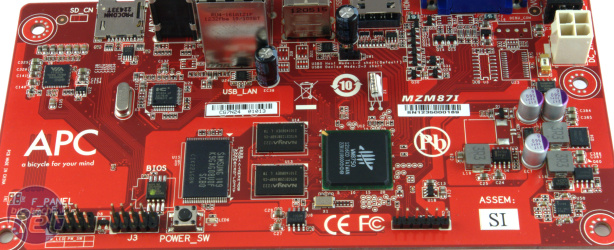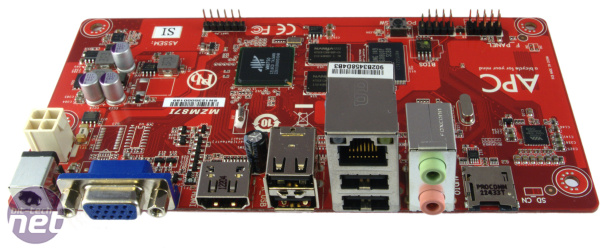VIA APC8750 review
November 13, 2012 | 10:45
Companies: #arm #debian #raspberry-pi #via #wondermedia

The APC8750 is its first attempt at duplicating the success of the Raspberry Pi. Based around the WonderMedia Prizm WM8750, the system has 800MHz of ARMv6 processing power and an OpenGL-ES 2.0 GPU at its disposal. Two chips of Nanya DDR3 memory provides 512MB of RAM, of which 64MB is reserved for GPU use and the rest given over to the system to do with as it pleases.
So far, so familiar: the APC practically invites comparisons with the Raspberry Pi. While the APC's processor offers more grunt by default, running at 800MHz to the Pi's 700MHz, the ARMv6 instruction set is identical - and identically outdated, failing to offer compatibility with modern operating systems such as Android 4.2 'Jelly Bean' and Canonical's Ubuntu Linux. The 512MB is more generous than the 256MB provided with the original Raspberry Pi Model B, but matched by the second hardware revision - and, unlike the Pi, there's no easy way to control the split between system and GPU reserved memory.
Where the APC8750 does begin to differ from its fruit-themed rival is in size and storage. VIA has chosen to launch a new form factor it calls 'neo-ITX,' a compact layout which nevertheless offers drop-in compatibility with mini-ITX and micro-ATX case types. That's not to be sniffed at: unlike the custom enclosures required of most ARM development boards, the APC can be hidden away in a wide variety of existing cases and powered from a 12V connector compatible with any recent PSU. The company even includes a custom back panel plate, cut out to reveal the APC's various ports.
Storage, meanwhile, is the APC8750's strong point. As well as a micro-SD card slot supporting up to 32GB cards, the board includes 2GB of on-board NAND flash. With an operating system pre-loaded, it's possible to plug the APC in to the power and go - something most rival boards, including the Pi, can't offer.
In addition to on-board front panel connects, a single SPI header and a UART header, the rear panel of the APC includes four full-performance USB 2.0 ports, two of which can be toggled between host and device modes, a 10/100 Ethernet port, HDMI and VGA outputs, and analogue audio input and output ports. A 2.5mm DC jack provides power for those not using the 12V connector, but no PSU is included in Europe - a shame, given that the APC is provided with a compatible 9V 1.5A supply in the US.
All this does come at a cost, however. There's no general-purpose input output (GPIO) capability on the APC, aside from the single SPI and UART connections, making it unsuitable for hardware hackers unless teamed with an Arduino or similar. The neo-ITX form factor also makes it larger than almost any other board on the market: at 170mm x 85mm, it's almost exactly the same volume as three Raspberry Pi boards sat side-by-side.
So far, so familiar: the APC practically invites comparisons with the Raspberry Pi. While the APC's processor offers more grunt by default, running at 800MHz to the Pi's 700MHz, the ARMv6 instruction set is identical - and identically outdated, failing to offer compatibility with modern operating systems such as Android 4.2 'Jelly Bean' and Canonical's Ubuntu Linux. The 512MB is more generous than the 256MB provided with the original Raspberry Pi Model B, but matched by the second hardware revision - and, unlike the Pi, there's no easy way to control the split between system and GPU reserved memory.
Where the APC8750 does begin to differ from its fruit-themed rival is in size and storage. VIA has chosen to launch a new form factor it calls 'neo-ITX,' a compact layout which nevertheless offers drop-in compatibility with mini-ITX and micro-ATX case types. That's not to be sniffed at: unlike the custom enclosures required of most ARM development boards, the APC can be hidden away in a wide variety of existing cases and powered from a 12V connector compatible with any recent PSU. The company even includes a custom back panel plate, cut out to reveal the APC's various ports.
Storage, meanwhile, is the APC8750's strong point. As well as a micro-SD card slot supporting up to 32GB cards, the board includes 2GB of on-board NAND flash. With an operating system pre-loaded, it's possible to plug the APC in to the power and go - something most rival boards, including the Pi, can't offer.
In addition to on-board front panel connects, a single SPI header and a UART header, the rear panel of the APC includes four full-performance USB 2.0 ports, two of which can be toggled between host and device modes, a 10/100 Ethernet port, HDMI and VGA outputs, and analogue audio input and output ports. A 2.5mm DC jack provides power for those not using the 12V connector, but no PSU is included in Europe - a shame, given that the APC is provided with a compatible 9V 1.5A supply in the US.
All this does come at a cost, however. There's no general-purpose input output (GPIO) capability on the APC, aside from the single SPI and UART connections, making it unsuitable for hardware hackers unless teamed with an Arduino or similar. The neo-ITX form factor also makes it larger than almost any other board on the market: at 170mm x 85mm, it's almost exactly the same volume as three Raspberry Pi boards sat side-by-side.

MSI MPG Velox 100R Chassis Review
October 14 2021 | 15:04










Want to comment? Please log in.